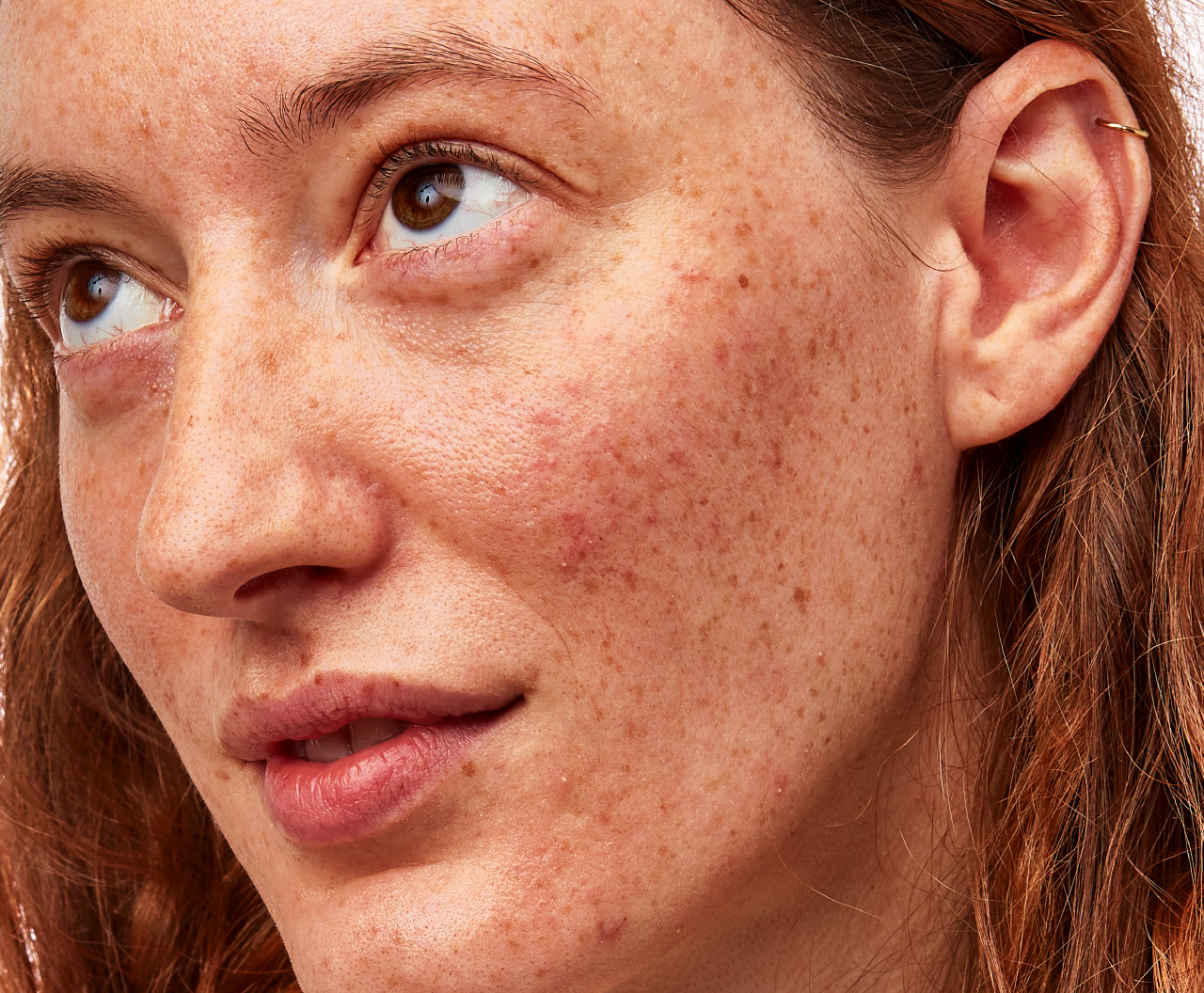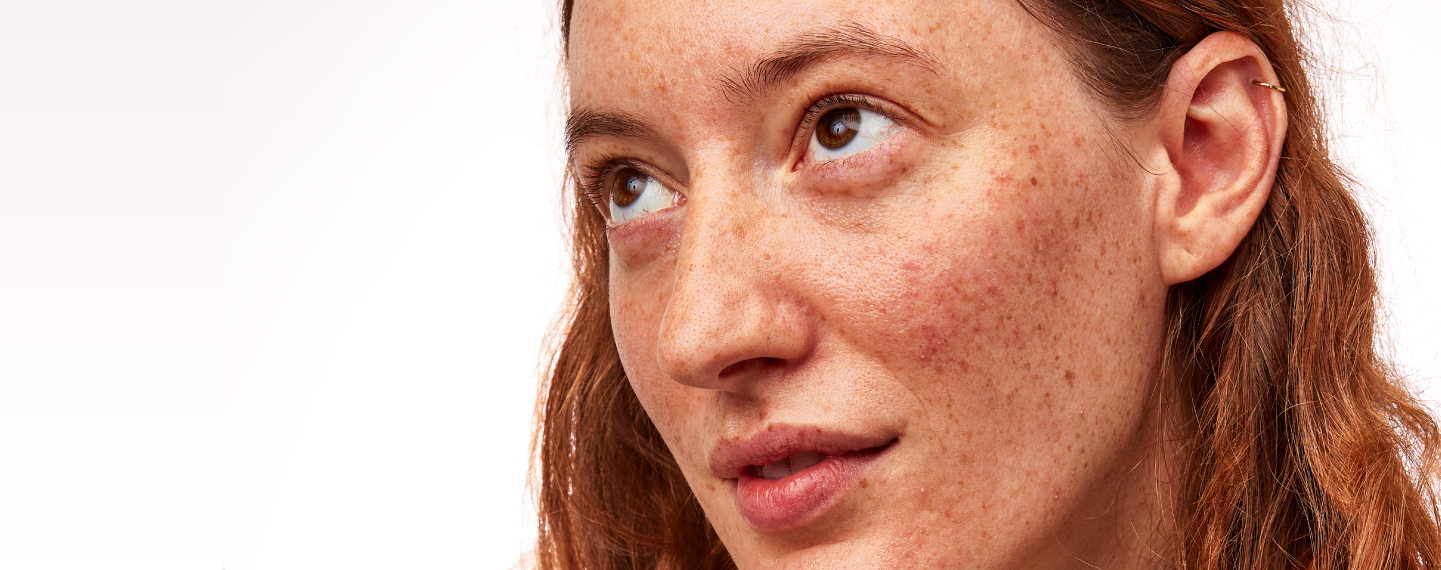Education
What is microneedling and should you try it?


SHARE
Education
What is microneedling and should you try it?
Medically reviewed by Kristin Hall, FNP
Written by Apostrophe Team
Last updated 4/1/2024
If you want firmer, younger-looking skin but you loathe the thought of plastic surgery, there is a less invasive treatment that might be worthy of your consideration—microneedling.
Microneedling involves inserting myriad tiny needles into the skin to boost collagen production and reduce the appearance of fine lines and wrinkles. As invasive as it may sound, the needles are tiny and the treatment feels more like a pinprick than anything else. Even if you’re afraid of needles, you should have no trouble sitting through this anti-aging treatment. Just make sure you apply sunscreen after the procedure!
By using the body’s own natural healing process, microneedling could be the anti-aging solution you’ve been looking for. Let’s take a closer look at how it works as well as the associated risks and benefits.
How Does Microneedling Work?
If you’re not a fan of the term microneedling, maybe you’ll be more comfortable with this one—collagen production therapy. It’s a minimally invasive treatment that dermatologists have been using for decades to treat facial scars, but it has recently become popular as an antiaging treatment, particularly with the release of at-home microneedling devices called dermarollers or micro-rollers.
Microneedling involves rolling a needle-covered device over the skin, poking hundreds of tiny, shallow holes in the surface of the skin.
Though the thought of being punctured by hundreds of tiny needles may not be your idea of fun, it can actually do great things for your skin. The needles create micro-injuries that prompt the skin to start the natural healing process that begins with collagen production. As your skin produces more collagen, you’ll find that fine lines fill in and wrinkles become less noticeable. Your skin will be fuller and more supple, giving you a youthful glow.
In addition to boosting collagen production for anti-aging benefits, microneedling can also fade acne scars, stretch marks, and surgical scarring in addition to improving your overall skin tone and texture. It may help reduce the appearance of pigmentation and large pores as well. Though it is primarily used on the face, it can also be used on other areas of the body.
What Happens During the Procedure?
Microneedling is a simple office-based procedure. The area to be treated is anesthetized with topical anesthesia for 45 minutes to one hour. After preparation of the area, rolling is done 15-20 times in horizontal, vertical, and oblique directions; Petechiae or pin-point bleeding which occurs is easily controlled. After treatment, the area is wetted with saline pads. The entire procedure lasts for 15 to 20 minutes, depending on the extent of the area to be treated. A minimum of six weeks is recommended between two treatments as it takes that long for new natural collagen to form. Three to four treatments may be needed for moderate acne scars.
What Are the Risks of Microneedling?
Microneedling is generally recognized as safe for healthy individuals, but not everyone is a good candidate for the procedure. If you are in good health and have certain skin conditions or problems that haven’t responded to at-home treatments, it might be an option to consider.
But what are the risks associated with microneedling that you should be aware of?
During the procedure, your healthcare provider will use a tool to make tiny pin pricks under the surface of the skin. The pinpricks are so small that you won’t be able to see them after the procedure, but the fact is that your skin is still being punctured so there is a small risk for infection. Your risk may be higher if you have certain skin diseases, or if you have open wounds on your face.
Prior to the procedure, your healthcare provider will apply a topical anesthetic to numb the area, but you may experience some soreness, itching, or minor irritation after the procedure.
Other side effects may include redness, bleeding, and possibly minor bruising. If you experience any of these side effects, contact your healthcare provider.
You may not be an ideal candidate for microneedling if you have a history of skin scars or if you’ve recently had radiation therapy. People with open wounds and skin conditions like eczema and psoriasis may not be recommended for the procedure.
Other contraindications for this procedure include having active acne, localized infections such as warts or herpes, rosacea, extreme keloidal tendency, and others.
What Should You Know Before You Try?
Whether you’re headed to the spa for a mud mask or trying a new beauty product, you should know what you’re getting yourself into before you actually do it. Microneedling is generally considered safe, but there are still certain things you should know before you go in for your first treatment:
How Much Does It Cost?
On average, microneedling costs anywhere from $100 to $700 per session, depending on the size of the area being covered. Most sessions cost around $300 and you may need more than one session to achieve the desired result.
You should also know that microneedling is considered a cosmetic procedure, so it is unlikely to be covered by your insurance. If you’re worried about the cost, ask your care center staff about financing options.
In addition to considering the cost of the procedure itself, you should also think about the costs associated with your recovery. Though microneedling is a minimally invasive procedure, you may want to take a few days off work until the irritation subsides. Factor this into your plan when thinking about the costs associated with microneedling.
Is It Going to Hurt?
There is no way that having your skin punctured hundreds of times won’t cause any pain, but your healthcare provider will apply a topical anesthetic about 30 minutes prior to the procedure to help dull the pain. Know that longer needles will hurt more, but most microneedling procedures that are performed by healthcare providers use needles that are 0.5mm to 2mm long. After the procedure, you should expect to feel some irritation and your skin will be a little red—like a sunburn—for a few days after.
If, after undergoing your first microneedling procedure, you aren’t sure you can endure another, know that your skin will become thicker as it heals. In each subsequent session, however, the healthcare provider will insert the needles a little deeper each time. Depending on your tolerance for pain, this can range from minor discomfort to a burning sensation.
Does It Work for Acne Scars?
Though typically used for , microneedling can also be used to reduce the appearance of atrophic scarring such as acne scars. An atrophic scar is an indented scar that heals below the outer layer of skin. It happens when the skin is unable to regenerate skin tissue and it is often the result of acne or chickenpox.
Several studies have shown the benefits of microneedling for atrophic scarring, specifically for facial scars caused by acne. In a , 10 patients were subjected to three months of microneedling treatments—six sessions spaced two weeks apart—then tested for collagen synthesis and evaluated for the severity of their scarring. At the end of the study, all 10 exhibited noticeable improvements in their scars and there was a statistically significant increase in collagen production.
What’s the Recovery Like?
Compared to many cosmetic procedures, microneedling has a short recovery period. For several days after the procedure, your skin may be a little red and you may experience some minor irritation. For the most part, however, side effects are mild and subside within a few days.
Should You Try It at Home?
Though you can find dermarollers for sale online, most dermatologists recommend against performing the procedure yourself at home.
As simple as it may seem to just roll the device across your skin, you should remember that you’re actually creating a wound in the skin. This opens you up to a risk for infection and, if you do it wrong, additional scarring. After microneedling, your skin may also be more sensitive to certain skincare products, so it is best to have the procedure performed by a licensed and experienced professional.
Whether you’re looking for a long-term solution for wrinkle reduction or you have facial scarring from acne that you’d rather live without, microneedling is an option to consider.
Before you consent to the procedure, be sure to do your own research so you are fully prepared for the procedure itself as well as the aftercare. Though minimally invasive, microneedling does come with certain risks and it is up to you to take care of your body by making smart, informed decisions regarding your health and wellness.
If you want more tips on how to keep your skin looking healthy and glowing, check out our article on four lifestyle changes to achieve glowing skin.
Like what you just read? Sign up for our email list to get the scoop on skincare science delivered straight to your inbox.

Education
What is milia?
What is milia? Today, we’re jumping into one type of bump that you may have heard about most commonly in infants — milia.
Read More
Education
Best moisturizer for acne-prone skin
If you have combination acne-prone skin, figuring out which moisturizer is best for your skin might be tough. In this guide, we break down the best moisturizer for combination, acne-prone skin.
Read More
Education
How to build a face care routine
As you get into skincare, it might seem overwhelming, especially trying to figure out the order you're supposed to apply products in. Below, we detail how to build a face care routine for your skin!
Read More